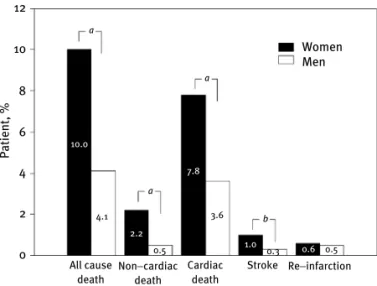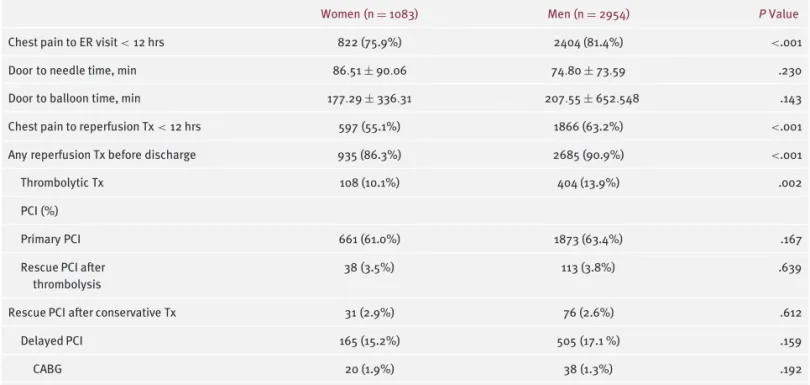Gender Differences in Clinical Features and In-hospital Outcomes in ST-segment Elevation Acute Myocardial Infarction:
From the Korean Acute Myocardial Infarction Registry (KAMIR) Study
Jong-Seon Park, MD; Young-Jo Kim, MD; Dong-Gu Shin, MD; Myung-Ho Jeong, MD;
Young-Keun Ahn, MD; Wook-Sung Chung, MD; Ki-Bae Seung, MD; Chong-Jin Kim, MD;
Myeong-Chan Cho, MD; Yang-Soo Jang, MD; Seung-Jung Park, MD; In-Whan Seong, MD;
Shung-Chull Chae, MD; Seung-Ho Hur, MD; Dong-Hoon Choi MD; Taek-Jong Hong, MD;
for the Korean Acute Myocardial Infarction Registry (KAMIR) Group
Department of Internal Medicine, Yeungnam University Hospital, Daegu, Korea (Park, Kim, Shin);
Department of Internal Medicine, Chonnam National University Hospital, Kwangju, Korea (Jeong, Ahn); Department of Internal Medicine, Catholic University Hospital, Seoul, Korea (Chung, Seung); Department of Internal Medicine, Kyunghee University Hospital, Seoul, Korea (Kim);
Division of Cardiology, Department of Internal Medicine, Chungbuk National University Hospital, Cheongju, Korea (Cho); Department of Internal Medicine, Yonsei University Severance Hospital, Seoul, Korea (Jang, Choi); Department of Internal Medicine, Asan Medical Center, Ulsan University, Seoul, Korea (Park); Department of Internal Medicine, Chungnam National University Hospital, Daejeon, Korea (Seong); Department of Internal Medicine, Kyungpook National University Hospital, Daegu, Korea (Chae); Department of Internal Medicine, Keimyung University Hospital, Daegu, Korea (Hur); Department of Internal Medicine, Busan National University Hospital, Busan, Korea (Hong)
# 317-1, Daemyung-dong, Nam-gu, Daegu 705-717, Korea yjkim@med.yu.ac.kr
Background: Studies have suggested that women are biologically different and that female gender itself is independently associated with poor clinical outcome after an acute myocardial infarction (AMI).
Hypothesis: We analyzed data from the Korean Acute Myocardial Infarction Registry (KAMIR) to assess gender differences in in-hospital outcomes post ST-segment elevation myocardial infarction (STEMI).
Methods: Between November 2005 and July 2007, 4037 patients who were admitted with STEMI to 41 facilities were registered into the KAMIR database; patients admitted within 72 hours of symptom onset were selected and included in this study.
Results: The proportion of patients who had reperfusion therapy within 12 hours from chest pain onset was lower in women. Women had higher rates of in-hospital mortality (8.6% vs 3.2%, P < .01), noncardiac death (1.5% vs 0.4%, P < .01), cardiac death (7.1% vs 2.8%, P < .01), and stroke (1.2% vs 0.5%, P < .05) than men.
Multivariate logistic regression analysis identified age, previous angina, hypertension, a Killip class ≥ II, a left ventricular ejection fraction (LVEF) <40%, and a thrombolysis in myocardial infarction flow (TIMI) grade
≤3 after angioplasty as independent risk factors for in-hospitaldeath for all patients; however, female gender itself was not an independent risk factor.
Conclusions: The results of this study show that although women have a higher in-hospital mortality than men, female gender itself is not an independent risk factor for in-hospital mortality.
Introduction
Ischemic heart disease is the leading cause of death world- wide. The prevalence of coronary artery disease is increas- ing and becoming a major cause of morbidity and mortality in Korea.
1Acute myocardial infarction (AMI) continues to be a major public health problem in the industrialized world. Recently, the Korean Acute Myocardial Infarction
Registry (KAMIR) study, a nationwide, multicenter study, was initiated to analyze the clinical characteristics of AMI in the Korean population. The current study was designed, based on data obtained from the KAMIR study, to elucidate gender differences among Korean AMI patients.
A gender gap has been suggested to be present in
coronary artery disease severity, percutaneous coronary
Clinical Investigations continued
intervention (PCI) outcomes, and short-term mortality among patients with acute myocardial infarction (AMI).
2−5One of the contributing factors to poorer outcomes in women is that women receive reperfusion therapy less often than men, which results in a higher incidence of severe myocardial necrosis.
6 – 7In addition, women have other risk factors that contribute to a poorer outcome.
6 – 8However, some studies have shown similar outcomes between genders after adjustment for other risk factors. One report suggested that the overall mortality is not different between genders, but that the timing and mechanism underlying AMI are different.
9The purpose of the present study was to determine and compare in-hospital outcomes after ST-segment elevation myocardial infarction (STEMI) and independent predictors of these outcomes in women and men.
Methods
This study is based on a database collected by the KAMIR National Registry Study. KAMIR is a prospective, multicenter registry study designed to characterize the clinical features and prognosis of AMI in Korean patients. All 41 cardiology centers in Korea were invited to participate in the KAMIR study. At participating sites, consecutive patients admitted with AMI were asked to register to be part of this study. Patients at all centers were eligible for thrombolytic therapy, and PCI was available for all acute STEMI patients. All treatment strategies including reperfusion therapy modality and medications were chosen at the discretion of the attending physicians.
Patients
From November 2005 to July 2007, 4037 consecutive patients were admitted to 41 cardiovascular facilities due to an acute STEMI within 72 hours after symptom onset. All patients were divided into 2 groups according to gender and were compared with regard to baseline clinical characteristics, angiographic findings, treatment modalities, and in-hospital outcomes. Among these patients, 1083 (27%) were women and 2954 (73%) were men.
The study protocol has been reviewed and approved by the institutional review boards of the participating centers.
Data Registry
Detailed data were obtained on patients’ demographics, treatment in the emergency room, catheterization findings, and clinical outcome during their hospital stay. Data was collected at each institution; a study coordinator or doctor entered the data into a password-protected, web-based, computerized database program provided by the KAMIR committee. Data coordinators attended meetings at least twice yearly for education; in addition, they reviewed and discussed the study protocol.
Definitions
ST-segment elevation myocardial infarction was diagnosed by a cardiologistin a patient with ≥2 of the followingcriteria:
(1) typical chest pain lasting >30 minutes; (2) development of pathological Q waves or ST-segment and T-wave changes in more than 2 ECG leads; and (3) the typical increase and decrease of serum creatinine kinase levels 2 × the upper limit of normal. Hypertension was defined as known hyper- tension or blood pressure (BP) ≥140/90 mm Hg based on the Joint National Committee on Prevention, Detec- tion, Evaluation, and Treatment of High Blood Pressure VII guidelines.
10The diagnosis of diabetes mellitus was based on fasting plasma glucose levels ≥126 mg per dL (7.0 mmol per L) or 2-hour postprandial plasma glucose (2 hr PPG) readings ≥200 mg per dL (11.1 mmol per L).
Metabolic syndrome was defined according to the Third Report of the National Cholesterol Education Program Expert Panel on Detection, Evaluation, and Treatment of High Blood Cholesterol in Adults (Adult Treatment Panel III)
11since, cut off values for the definition of obesity in Asian populations have been revised and criteria for metabolic syndrome modified.
12Metabolic syndrome was diagnosed if 3 or more of the following criteria were satisfied:
(1) obesity, defined by a abdominal circumference >90 cm in men or >80 cm in women; (2) hypertriglyceridemia if the triglyceride level was ≥150 mg/dL; (3) low high-density lipoprotein cholesterol <40 mg/dL in men or <50 mg/dL in women; (4) hypertension, defined as known hypertension or a BP ≥130/85 mm Hg;, and (5) dysglycemia, defined as known diabetes or a fasting plasma glucose ≥110 mg/dL.
Dyslipidemia was defined as a fasting total cholesterol concentration of ≥200 mg/dL, a fasting triglyceride con- centration of ≥200 mg/dL, or the use of treatment with medication for dyslipidemia.
In-hospital mortality included death from any cause, cardiac and noncardiac, that occurred before discharge.
Cardiogenic shock was defined as a systolic blood pressure
<90 mm Hg for at least 10 minutes with evidence of poor tissue perfusion. Cardiac death was defined as mortality directly related to: (1) cardiogenic shock or congestive heart failure; (2) mechanical complications such as free wall and ventricular septal wall rupture; and (3) sudden arrhythmic death. Noncardiac deaths, such as sepsis and pneumonia, were included in the in-hospital deaths.
Statistical Analysis
Data were expressed as proportions or mean value ± SD. Differences in categorical variables between the 2 groups were analyzed by the χ
2test and differences in continuous variables were analyzed by the 2-tailed unpaired t test. Multivariate logistic regression analysis was used to determine independent predictors of in-hospital mortality.
Statistical significance was defined as a P value of <.05.
Baseline Characteristics
Differences in demographics, medical history, clinical characteristics, and reperfusion therapy are shown in Table
Table 1. Patient Baseline Characteristics Women
(n = 1083) Men
(n = 2954) P Value
Age, years 72.1 ± 9.7 60.7 ± 12.5 <.001
BMI, kg/m
223.5 ± 3.6 24.1 ± 3.1 <.001
Metabolic 751 (69.3%) 1332 (45.1%) <.001
syndrome
Previous angina 70 (6.5%) 126 (4.3%) .004
Previous MI 31 (2.9%) 107 (3.6%) .239
Previous CABG 3 (0.3%) 15 (0.5%) .330
Previous PCI 30 (2.8%) 128 (4.3%) .023
Stroke 80 (7.4%) 159 (5.4%) .017
Diabetes 333 (31.4%) 667 (23.1%) <.001
Hypertension 640 (59.7%) 1168 (40.2%) <.001
Smoking 159 (14.7%) 1738 (58.8%) <.001
Dyslipidemia 560 (51.7%) 1306 (44.2%) <.001 MI location
Anterior 549 (53.6%) 1528 (54.4%) .911
Inferior 425 (41.5%) 1143 (40.7%)
Lateral 36 (3.5%) 105 (3.7%)
Posterior 14 (1.4%) 33 (1.2%)
Peak CK-MB, 1485 ± 1671 2022 ± 2435 <.001
ng/mL
Killip class ≥ 361 (34.7%) 661 (23.2%) <.001 II on admission
Cardiogenic 92 (8.5%) 144 (4.9%) <.001
shock on admission
IABP 63 (5.8%) 127 (4.3%) .044
LVEF, % 49.77 ± 12.518 50.37 ± 11.923 .192
Abbreviations: BMI= body mass index; CABG = coronary artery bypass graft surgery; IABP= intra-aortic balloon pump; LVEF = left ventricu- lar ejection fraction; MI = myocardial infarction; PCI = percutaneous coronary intervention.
8
6
Patient, %
4
2
0
All cause death
4.1
0.5
3.6
0.3 0.6 0.5 1.0
7.8
2.2 10.0
Non−cardiac death
Cardiac death
Stroke Re−infarction a
a
b

